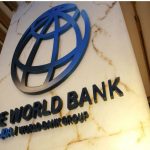World Bank shields Kenya from costly foreign debt – Business Daily
Signage of the World Bank. PHOTO | POOL
Kenya has relied heavily on the World Bank Group for foreign funding since January on the back of a relatively high-interest international market that saw the Treasury shun expensively-priced commercial loans.
The latest Treasury data on external borrowing shows the stock of debt from rich countries (bilateral) as well as commercial lenders — banks and Eurobond — fell in the four months ended April.
Loans from multilateral lenders, however, increased Sh95.71 billion on net borrowing basis — driven by World Bank’s International Development Association (IDA) and Asian Development Bank/Asian Development Fund (ADB/ADF).
The two multilateral financiers, whose loans come on concessional terms as low as 0.5 percent interest and a longer repayment period with a generous grace period, accounted for nearly three-quarters of the growth in multilateral debt and 95.5 percent of the net external debt.
The Treasury’s Public Debt Management Office has been keen on tapping concessional loans which have longer repayment period and cut on expensive, short-term borrowing to ease pressure on the cash flow.
Loans from IDA — which largely targets world’s poorest developing countries — increased Sh52.78 billion between January and April to nearly Sh1.18 trillion, according to the update by the Treasury.
Loans from ADB/ADF, on the other hand, increased Sh18.35 billion to close at Sh379.03 billion.
Overall, Kenya’s public and publicly guaranteed foreign debt rose Sh69.16 billion to Sh4.24 trillion on inflows from multilateral lenders. Commercial and bilateral debt stock fell Sh12.59 billion and Sh8.61 billion, respectively.
“This (growth in external debt stock) was attributed to disbursements and foreign exchange rates movement,” the Treasury wrote in the April bulletin, the latest monthly update.
The shilling weakened 2.33 percent between January and April against the US dollar, the biggest currency in which Kenya’s debt is denominated.
The Treasury is required under section 31(3) of the Public Finance Management Act to file a report on external loans after every four months in the National Assembly.
For the period through April 2022, the Treasury signed nine external loan deals worth Sh137.93 billion.
Six of the loans worth Sh132.38 billion, or 95.97 percent of the new loan deals, were signed separately with the World Bank Group under different programmes.
The remainder Sh5.55 billion loan deals were procured from three bilateral lenders — France (Sh2.69 billion), Germany (Sh2.08 billion) and Italy (Sh782.55 million).
“Two of the (nine) loans have been disbursed by the time of submitting this report (May 19),” the Treasury wrote in the report to Parliament without disclosing the creditors which had wired the cash.
Latest Treasury disclosures in the Kenya Gazette indicate the country had by May taken Sh172.17 billion, or 39.75 percent, of Sh433.16 billion external borrowing and grants target for the financial year ending this June.
Under the external borrowing, Kenya had targeted $1 billion (Sh117 billion) Eurobond which it has abandoned due to high-interest demands of about 12 percent, nearly double 6.3 percent it paid last financial year for a similar amount.
“In our funding for this financial year, we factored in borrowing from the international market, the Eurobond. But we realised as a result of challenges in Russia and Ukraine the cost of borrowing has gone really high,” Treasury Secretary Ukur Yatani said earlier this month.
“Last year we borrowed at six percent, right now it stands over 12 percent and this is no longer feasible. That is why we are still exploring options to look at a number of banks that can advance us the money at a cheaper rate, a figure more or less than a figure of last year, an average of six percent.”
[email protected]












